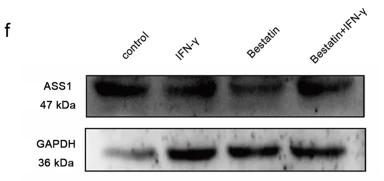ASS1 Antibody - #BF0242
| Product: | ASS1 Antibody |
| Catalog: | BF0242 |
| Description: | Mouse monoclonal antibody to ASS1 |
| Application: | WB IHC ELISA |
| Cited expt.: | WB, IHC |
| Reactivity: | Human, Mouse, Monkey |
| Mol.Wt.: | 47kDa; 47kD(Calculated). |
| Uniprot: | P00966 |
| RRID: | AB_2833984 |
Product Info
*The optimal dilutions should be determined by the end user. For optimal experimental results, antibody reuse is not recommended.
*Tips:
WB: For western blot detection of denatured protein samples. IHC: For immunohistochemical detection of paraffin sections (IHC-p) or frozen sections (IHC-f) of tissue samples. IF/ICC: For immunofluorescence detection of cell samples. ELISA(peptide): For ELISA detection of antigenic peptide.
Cite Format: Affinity Biosciences Cat# BF0242, RRID:AB_2833984.
Fold/Unfold
Argininosuccinate synthase 1; Argininosuccinate synthase; Argininosuccinate synthetase 1; ASS; Ass-1; ass1; ASSA; ASSY_HUMAN; Citrulline aspartate ligase; Citrulline--aspartate ligase; CTLN1;
Immunogens
Purified recombinant fragment of human ASS1 expressed in E. Coli.
- P00966 ASSY_HUMAN:
- Protein BLAST With
- NCBI/
- ExPASy/
- Uniprot
MSSKGSVVLAYSGGLDTSCILVWLKEQGYDVIAYLANIGQKEDFEEARKKALKLGAKKVFIEDVSREFVEEFIWPAIQSSALYEDRYLLGTSLARPCIARKQVEIAQREGAKYVSHGATGKGNDQVRFELSCYSLAPQIKVIAPWRMPEFYNRFKGRNDLMEYAKQHGIPIPVTPKNPWSMDENLMHISYEAGILENPKNQAPPGLYTKTQDPAKAPNTPDILEIEFKKGVPVKVTNVKDGTTHQTSLELFMYLNEVAGKHGVGRIDIVENRFIGMKSRGIYETPAGTILYHAHLDIEAFTMDREVRKIKQGLGLKFAELVYTGFWHSPECEFVRHCIAKSQERVEGKVQVSVLKGQVYILGRESPLSLYNEELVSMNVQGDYEPTDATGFININSLRLKEYHRLQSKVTAK
Research Backgrounds
One of the enzymes of the urea cycle, the metabolic pathway transforming neurotoxic amonia produced by protein catabolism into inocuous urea in the liver of ureotelic animals. Catalyzes the formation of arginosuccinate from aspartate, citrulline and ATP and together with ASL it is responsible for the biosynthesis of arginine in most body tissues.
Acetylated by CLOCK in a circadian manner which negatively regulates its enzyme activity. Deacetylated by histone deacetylases.
Cytoplasm>Cytosol.
Expressed in adult liver.
Belongs to the argininosuccinate synthase family. Type 1 subfamily.
Research Fields
· Metabolism > Amino acid metabolism > Arginine biosynthesis.
· Metabolism > Amino acid metabolism > Alanine, aspartate and glutamate metabolism.
· Metabolism > Global and overview maps > Metabolic pathways.
· Metabolism > Global and overview maps > Biosynthesis of amino acids.
References
Application: WB Species: Human Sample: BMECs
Application: IHC Species: Human Sample: breast cancer cell
Application: IHC Species: Human Sample:
Restrictive clause
Affinity Biosciences tests all products strictly. Citations are provided as a resource for additional applications that have not been validated by Affinity Biosciences. Please choose the appropriate format for each application and consult Materials and Methods sections for additional details about the use of any product in these publications.
For Research Use Only.
Not for use in diagnostic or therapeutic procedures. Not for resale. Not for distribution without written consent. Affinity Biosciences will not be held responsible for patent infringement or other violations that may occur with the use of our products. Affinity Biosciences, Affinity Biosciences Logo and all other trademarks are the property of Affinity Biosciences LTD.



